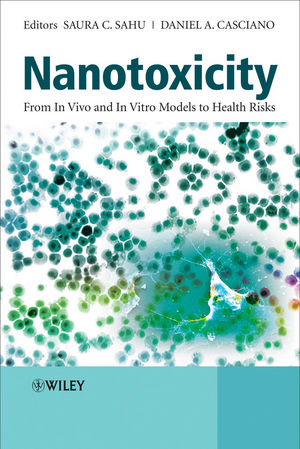
Contents
Preface xi
List of Contributors xiii
Acknowledgments xix
1 Characterization of Nanomaterials for Toxicological Evaluation 1
Kevin W. Powers, Maria Palazuelos, Scott C. Brown and
Stephen M. Roberts
2 Criteria and Implementation of Physical and Chemical
Characteristics of Nanomaterials for Human Health Effects and
Ecological Toxicity Studies 29
Christie M. Sayes and David B. Warheit
3 Considerations for the Design of Toxicity Studies of
Inhaled Nanomedicines 41
Lea Ann Dailey
4 High Aspect Ratio Nanoparticles and the Fibre
Pathogenicity Paradigm 61
Craig A. Poland, Rodger Duffin and Ken Donaldson
5 Application of Zinc Oxide Quantum Dots in Food Safety 81
Tony Jin, Dazhi Sun, Howard Zhang and Hung-Jue Sue
6 Evaluation of Nanotoxicity of Foods and Drugs: Biological Properties
of Red Elemental Selenium at Nano Size (Nano-Se) In Vitro and
In Vivo 97
Jinsong Zhang
7 Evaluation of Toxicity of Nanostructures in Biological Systems 115
Adam J. Gormley and Hamidreza Ghandehari
8 Developing Bioassay Methods for Evaluating Pulmonary
Hazards from Nanoscale or Fine Quartz/Titanium Dioxide
Particulate Materials 161
David B. Warheit, Kenneth L. Reed and Christie M. Sayes
9 Nanoparticles: Is Neurotoxicity a Concern? 171
Jianyong Wang, Wenjun Sun and Syed F. Ali
10 Hepatotoxic Potential of Nanomaterials 183
Saura C. Sahu
11 Nanotoxicity in Blood: Effects of Engineered Nanomaterials on
Platelets 191
Jan Simak
12 Sources, Fate and Effects of Engineered Nanomaterials in the
Aquatic Environment 227
David S. Barber, Nancy D. Denslow, R. Joseph Griffitt and
Christopher J. Martyniuk
13 Nanotoxicity of Metal Oxide Nanoparticles in Vivo 247
Weiyue Feng, Bing Wang and Yuliang Zhao
14 In Vivo Hypersensitive Pulmonary Disease Models for Nanotoxicity 271
Ken-ichiro Inoue and Hirohisa Takano
15 In Vivo and In Vitro Models for Nanotoxicology Testing 279
Rosalba Gornati, Elena Papis, Mario Di Gioacchino, Enrico Sabbioni,
Isabella Dalle Donne, Aldo Milzani and Giovanni Bernardini
16 In Vitro and In Vivo Toxicity Study of Nanoparticles 303
Jayoung Jeong, Wan-Seob Cho, Seung Hee Kim and Myung-Haing Cho
17 In Vitro and In Vivo Models for Nanotoxicity Testing 335
Kyung O. Yu, Laura K. Braydich-Stolle, David M. Mattie, John J. Schlager
and Saber M. Hussain
18 In Vitro Models for Nanotoxicity Testing 349
Yinfa Ma
19 In Vitro Human Lung Cell Culture Models to Study the Toxic
Potential of Nanoparticles 379
Fabian Blank, Peter Gehr and Barbara Rothen-Rutishauser
20 Iron Oxide Magnetic Nanoparticle Nanotoxicity: Incidence and
Mechanisms 397
Thomas R. Pisanic, Sungho Jin and Veronica I. Shubayev
21 Toxicity Testing and Evaluation of Nanoparticles: Challenges in
Risk Assessment 427
David Y. Lai and Philip G. Sayre
22 Evaluating Strategies For Risk Assessment of Nanomaterials 459
Nastassja Lewinski, Huiguang Zhu and Rebekah Drezek
23 Strategies for Risk Assessment of Nanomaterials 499
Hae-Seong Yoon, Hyun-Kyung Kim, Dong Deuk Jang and
Myung-Haing Cho
24 Metal Nanoparticle Health Risk Assessment 519
Mario Di Gioacchino, Nicola Verna, Rosalba Gornati, Enrico Sabbioni
and Giovanni Bernardini
25 Application of Toxicology Studies in Assessing the Health Risks of
Nanomaterials in Consumer Products 543
Joyce S. Tsuji, Fionna S. Mowat, Suresh Donthu and Maureen Reitman
26 Safety Assessment of Engineered Nanomaterials in Direct Food
Additives and Food Contact Materials 581
Penelope A. Rice, Kimberly S. Cassidy, Jeremy Mihalov and
T. Scott Thurmond
Index 597
Preface
Nanotechnology is a rapidly developing, emerging branch of modern technology. This new technology deals with materials of extremely small size, generally in the range of nanometres. The nanomaterials, with their extremely small size and high surface area associated with greater strength, stability, chemical and biological activity, find their wide range of applications in a variety of products in modern society. They are used in rapidly increasing nanoproducts, nanodevices, electronics, diagnostics and drug delivery systems. They are present in a variety of consumer products such as foods, drugs, cosmetics, food colour additives, food containers, paints and surface coatings. This trend is expected to result in an ever-increasing presence of nanoparticles in the human environment. Because of their extremely small size they are capable of entering the human body by inhalation, ingestion, skin penetration, intravenous injections and medical devices, and have the potential to interact with intracellular macromolecules. Because of their greater stability they are anticipated to remain in the body and in the environment for long periods of time. However, information on their potential adverse health effects is very limited at the present time. It is not known at what concentration or size they can exhibit toxicity. Therefore, there are obvious public safety concerns. This has led to the initiation of a new research discipline commonly known as nanotoxicology.
The main purpose of this book is to assemble up-to-date, state-of-the-art toxicological information on nanomaterials presented by recognized experts in a single edition. Therefore, it is an authoritative source of current knowledge in this area of research. The book is designed primarily for research scientists currently engaged in this field. However, it should be of interest to a variety of scientific disciplines including toxicology, genetics, medicine and pharmacology, as well as drug and food and material sciences. Also, it should be of interest to federal regulators and risk assessors of drug, food, environment and consumer products.
Nanotoxicology is an emerging newmultidisciplinary field of science, and therefore there is a risk of change in its rapid development in the near future. However, its fundamental concepts and ideas as well as the experimental data are not going to change. For years to come this book will be a very valuable reference source to students and investigators in this research field to guide them in their future work.
